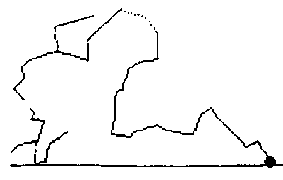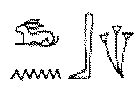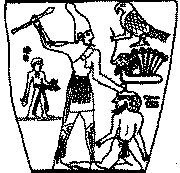What's in a Name?
Ancient Egyptians and the Constellations: Part 21
"Aa's frum Weshin'ton"
Have you ever wondered how Washington got its name or why the original Washington Village is situated where it is? It is from the name itself that we derive the answer.
The name comes in a multiple of varieties: for example Washington, Weshington, Wessington, and Wessynton. Locally we pronounce it Weshin'ton … "Aa's frum Weshin'ton." For our purposes let us refer to the Wessington version.
"Wessington" can be broken down into two separate words: "Wessing" and "ton". By analysing the meaning of these two words we learn that the name accurately describes the natural landform of the original Village area before settlement.
"Wesing" is an old Anglo-Saxon word meaning "soaking" or "steeping". The modern German noun equivalent is "Wasser" meaning "water". The Modern English noun equivalent is "water" and "wash". A wash is a body of water; as in The Wash on the East Coast. In addition however both words are linked with making clean, both physically and spiritually. Water is an accepted symbol for the Word of God.
Today it is difficult to imagine The Village awash with water but let us not forget the old sandpit in the Glebe area which indicates the presence of a large body of water in the past. There was another sandpit down The Dene.

When the waters receded the land would have been at first "soaking" underfoot. The final remnant of the "wash" was the Village Pond, which is now filled in and referred to as the Village Green. I wonder what treasures lie metres deep under the Village Green.

If you take a close look at the lie of the land around The Village, you will notice that even today the location of the Village Pond is a natural drainage area. The Home Bank (now called The Avenue), Village Lane, Spout Lane and Glebe Crescent as far as Glebe Mount, all drain down naturally into the area known as The Green.

On the left is the Washington Village Post Office
and in the centre is the Old Smithy.


The cars in the picture will go over the crest of the hill and then
down the other side into the Village Green area.
"Ton" at the end of a place name does not, as many people mistakenly believe, refer to an early form of the word "town". Nor does it necessarily refer to a "homestead". Rather it is another form of the old Anglo-Saxon word "torr" meaning "a prominent hill". "Torr" is a version of the Hebrew "tur" meaning "round tower" in the form of a mountain. Our English word "turret" is derived from this. At the end of a place name "tor" and "ton" take on an added significance; they both mean "a holy hill".
There is only one holy hill in Washington Village and that is the one upon which the Holy Trinity Church stands.

The Church on the Hill
And so the name Washington / Wessington literally describes its natural features at three stages of development:

Washington Village and the Druids
"Ton" at the end of a place name not only denotes a "holy hill", it denotes a holy hill which was sacred to Venus and which was of special significance to the Druids.
Venus, although a planet, is referred to by astronomers as "The Evening and Morning Star". The idea being portrayed is that of Death and Rebirth. This confirms that Death and Rebirth, or Resurrection, were central to the Druid religious philosophy; as they were to that of the Ancient Egyptians.
Tradition tells us that the person who is responsible for introducing religion and culture to Britain was the Celt/Druid Hesus. In this, his role was not unlike that of Osiris, who was the source of all knowledge in Ancient Egypt. (See Part 3)
The connection with ancient Egypt however does not end here. Hesus was also known as Hu. (See Part 2) His very name Hesus/Hu, together with his role, embodies the Sacred Knowledge of the Ancient Egyptians … that of Hu the Celestial Sphinx, Creation, and the Precession of the Equinoxes.(See Parts 1-13)

Druid mythology relates that Hesus/Hu was fathered by God and born of a virgin mother, Mayence in the 9th century BC. He was later crucified but his soul survived after Death. Sound familiar?
It was upon the "holy hill" that the Druids held an annual ceremony in which they re-enacted the crucifixion of Hesus. This was called the Beltane Festival.
In Washington Village this ceremony could only have been held on the current site of the Holy Trinity Church.

the Church on the Hill.
In the Beltane ritual ceremony Hesus/Hu was crucified on an oak tree which was symbolic of the Tree of Life.
Imagine the scene at "Wesington" two millennia and more in the past … a sturdy oak tree standing atop a holy hill which was possibly still surrounded by water. It was a sacred island; a sacred mound. The present day site of the Holy Trinity Church was, and still is, a sacred mound. A "holy hill" is another way of saying "sacred mound".
The Tree of Life and Washington Village
In mythology the Tree of Life grew out of the Sacred Mound, it's branches reaching out and supporting the star and planet studded sky, while it's roots reached down into the watery abyss of the Netherworld. The trunk of the Tree of Life represented the World Pillar or Axis Munde (literally "Axis of the Mound") around which the heavens appeared to revolve. The World Pillar was the centre of the universe.
Similarly, the Sacred Oak on the Sacred Mound at Washington Village was a world pillar representing the centre of the universe.

which represented the Centre of the Universe.
The earliest reference to the concept of the Tree of Life is to be found in the philosophy of the Ancient Egyptians. They explained the origin of the universe in terms of a primordial ocean called Nun. It wasn't flat; rather it was in the shape of a cosmic egg … and from this cosmic egg was born the primeval hill called Nu. Of the Tree of Life is written, "I am the plant which comes from Nu."
The key elements of the landscape at Washington Village before settlement are identical to those outlined in Ancient Egyptian cosmology! Sacred water, a sacred mound and a sacred tree.
The Ancient Egyptian symbol for "plant" meaning "Tree of Life" was three sacred lotus lilies. They have tree stems curving to the left as though blown by the easterly wind; and on top of each stem is the Lotus flower. The glyph which denotes the sacred knowledge associated with Hesus is also formed by the three stems of the three sacred lotus lilies.










